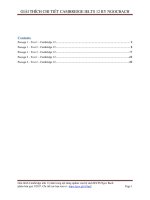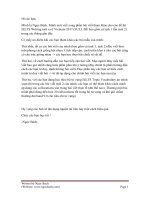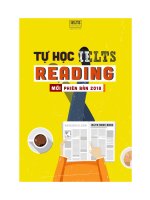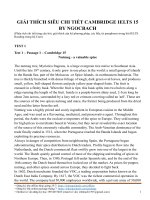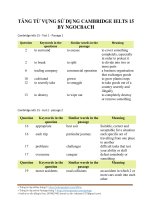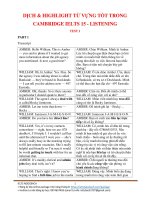Giai de cambridge ielts 15
Bạn đang xem bản rút gọn của tài liệu. Xem và tải ngay bản đầy đủ của tài liệu tại đây (1.98 MB, 137 trang )
1
Hướng dẫn sử dụng tài liệu hiệu quả:
Cambridge IELTS là bộ tài liệu đề thi gần sát với đề thi thật do chính tổ chức
Cambridge (tổ chức sáng lập kỳ thi IELTS phát hành). Chính vì vậy mà đây là
nguồn tham khảo và luyện tập vô cùng hiệu quả. Đặc biệt bộ sách Cambridge
15 mới phát hành.
Tuy nhiên, do thiếu phần hướng dẫn và giải chi tiết nên các học viên khi sử
dụng bộ tài liệu này cảm thấy khó khăn hơn. Thấu hiểu điều đó mà tập thể giáo
viên và nhân viên phát triển chất lượng đào tạo tại WISE ENGLISH đã chung
tay lại biên soạn bộ Giải đề Cambridge IELTS 15. Đây là món quà trung tâm
gửi tặng các bạn học viên IELTS trên cả nước để chinh phục điểm cao trong kì
thi IELTS nhé!
Để sử dụng bộ tài liệu hiệu quả các bạn cần:
Làm đề trước khi xem đáp án – giải chi tiết!
Để học tập tốt, các bạn nên làm đề và tự chấm – kiểm tra bài làm của mình rồi
mới xem đáp án, giải chi tiết. Khi đó các bạn mới rút ra được những bài học
cho bản thân mình tốt nhất. Đừng quên rút ra các điểm hay của hướng dẫn, bài
mẫu cho bản thân nhé!
Bản quyền được sở hữu bởi WISE ENGLISH. Đề nghị các cá nhân hay tổ
chức, đơn vị không được sao chép khi chưa có được sự đồng ý của WISE
ENGLISH.
2
Sứ mệnh: Sứ mệnh của WISE ENGLISH là giúp các bạn trẻ Việt Nam thay đổi
phương pháp học tiếng Anh theo Tư duy não bộ (NLP) và Ngôn ngữ để chinh phục
ngôn ngữ này một cách nhanh nhất và hiệu quả nhất.
Tầm nhìn: Trở thành hệ thống trung tâm Anh ngữ số 1 Việt Nam, trải dài khắp đất
nước, tập trung vào chất lượng giảng dạy, thay đổi phương pháp học truyền thống,
đồng thời truyền cảm hứng cho các bạn trẻ Việt Nam
Phương pháp học: Các phương pháp học khác biệt tại WISE ENGLISH dựa trên
các nguyên tắt nền tảng của Khoa học Tư duy Não bộ (Neuro-Linguistic Programming hay cịn gọi là Ngơn ngữ Lập trình Tư duy) và Khoa học Ngôn ngữ
(Linguistics).
NLP nghiên cứu tiềm năng và cách vận hành của Bộ não trong việc ghi nhớ thông
tin, học tập. Khoa học Ngôn ngữ (Linguistics) nghiên cứu về việc học Ngôn ngữ một
cách tự nhiên, như một đứa trẻ, làm sao giao tiếp được lưu loát.
Dựa trên các nguyên tắc nền tảng của hai ngành khoa học trên, WISE ENGLISH đã
tạo nên và phát triển 02 Phương pháp học đặc biệt, giúp học viên rút ngắn 80% thời
gian học mà vẫn đạt kết quả cao. Học viên sẽ trở về học Ngôn ngữ một cách Tự
nhiên nhất. Phương pháp này đã giúp hàng ngàn học viên Giao tiếp lưu loát và đạt
IELTS 6.0/6.5+
Cơ sở Hàm Nghi: 146 Hàm Nghi, quận Thanh Khê, thành phố Đà Nẵng
Hotline: 0901.270.888
Cơ sở Trần Văn Dư: 36 Trần Văn Dư, quận Hải Châu, thành phố Đà Nẵng
Hotline: 0901.290.777
Website: />Fanpage: />3
GIẢI ĐỀ CHI TIẾT
CAMBRIDGE IELTS 15
Biên soạn: WISE ENGLISH Team
4
Table of Contents
TEST 1 ......................................................................................................................................................... 6
ACADEMIC IELTS CAMBRIDGE 15 TEST 1 ...................................................................................... 7
I. READING ............................................................................................................................................. 7
II. SPEAKING ........................................................................................................................................ 31
III. WRITING ......................................................................................................................................... 38
TEST 2 ....................................................................................................................................................... 41
ACADEMIC IELTS CAMBRIDGE 15 TEST 2 .................................................................................... 42
I. READING ........................................................................................................................................... 42
II. SPEAKING ........................................................................................................................................ 67
III. WRITING ......................................................................................................................................... 74
TEST 3 ....................................................................................................................................................... 77
ACADEMIC IELTS CAMBRIDGE 15 TEST 3 .................................................................................... 78
I. READING ........................................................................................................................................... 78
II. SPEAKING ........................................................................................................................................ 96
III. WRITING ....................................................................................................................................... 102
TEST 4 ..................................................................................................................................................... 105
ACADEMIC IELTS CAMBRIDGE 15 TEST 4 .................................................................................. 106
I. READING ......................................................................................................................................... 106
II. SPEAKING .................................................................................................................................... 1299
III. WRITING ..................................................................................................................................... 1355
5
GIẢI ĐỀ CHI TIẾT
CAMBRIDGE IELTS 15
TEST 1
Biên soạn: WISE ENGLISH Team
6
ACADEMIC IELTS CAMBRIDGE 15 TEST 1
I. READING
READING PASSAGE 1
Nutmeg — a valuable spice
[1] The nutmeg tree, Myristica fragrans, is a large evergreen tree native to Southeast
Asia. Until the late 18th century, it only grew in one place in the world: a small group of
islands in the Banda Sea, part of the Moluccas — or Spice Islands — in northeastern
Indonesia. The tree is thickly branched with dense foliage of tough, dark green oval leaves,
and produces small, yellow, bell-shaped flowers and pale yellow pear-shaped fruits. The
fruit is encased in a fleshy husk. When the fruit is ripe, this husk splits into two halves along
a ridge running the length of the fruit. Inside is a purple-brown shiny seed, 2-3 cm long by
about 2 cm across, surrounded by a lacy red or crimson covering called an 'aril'. These are
the sources of the two spices nutmeg and mace, the former being produced from the dried
seed and the latter from the aril.
[2] Nutmeg was a highly prized and costly ingredient in European cuisine in the Middle
Ages, and was used as a flavouring, medicinal, and preservative agent. Throughout this
period, the Arabs were the exclusive importers of the spice to Europe. 'Illey sold nutmeg for
high prices to merchants based in Venice, but they never revealed the exact location of the
source of this extremely valuable commodity. The Arab- Venetian dominance of the trade
finally ended in 1512, when the Portuguese reached the Banda Islands and began exploiting
its precious resources.
[3] Always in danger of competition from neighbouring Spain, the Portuguese began
subcontracting their spice distribution to Dutch traders. Profits began to flow into the
Netherlands, and the Dutch commercial fleet swiftly grew into one of the largest in the
world. The Dutch quietly gained control of most of the shipping and trading of spices in
Northern Europe. Then, in 1580, Portugal fell under Spanish rule, and by the end of the
16th century the Dutch found themselves locked out of the market. As prices for pepper,
nutmeg, and other spices soared across Europe, they decided to fight back.
[4] In 1602, Dutch merchants founded the VOC, a trading corporation better known as the
Dutch East India Company. By 1617, the VOC was the richest commercial operation in the
world. The company had 50,000 employees worldwide, with a private army of 30,000 men
and a fleet of 200 ships. At the same time, thousands of people across Europe were dying of
the plague, a highly contagious and deadly disease. Doctors were desperate for a way to
stop the spread of this disease, and they decided nutmeg held the cure. Everybody wanted
7
nutmeg, and many were willing to spare no expense to have it. Nutmeg bought for a few
pennies in Indonesia could be sold for 68,000 times its original cost on the streets of
London. The only problem was the short supply. And that‘s where the Dutch found their
opportunity.
[5] The Banda Islands were ruled by local sultans who insisted on maintaining a neutral
trading policy towards foreign powers. This allowed them to avoid the presence of
Portuguese or Spanish troops on their soil, but it also left them unprotected from other
invaders. In 1621, the Dutch arrived and took over. Once securely in control of the Bandas,
the Dutch went to work protecting their new investment. They concentrated all nutmeg
production into a few easily guarded areas, uprooting and destroying any trees outside the
plantation zones. Anyone caught growing a nutmeg seedling or carrying seeds without the
proper authority was severely punished. In addition, all exported nutmeg was covered with
lime to make sure there was no chance a fertile seed which could be grown elsewhere
would leave the islands. There was only one obstacle to Dutch domination. One of the
Banda Islands, a sliver of land called Run, only 3 km long by less than 1 km wide, was
under the control of the British. After decades of fighting for control of this tiny island, the
Dutch and British arrived at a compromise settlement, the Treaty of Breda, in 1667. Intent
on securing their hold over every nutmeg-producing island, the Dutch offered a trade: if the
British would give them the island of Run, they would in turn give Britain a distant and
much less valuable island in North America. The British agreed. That other island was
Manhattan, which is how New Amsterdam became New York. The Dutch now had a
monopoly over the nutmeg trade which would last for another century.
[6] Then, in 1770, a Frenchman named Pierre Poivre successfully smuggled nutmeg
plants to safety in Mauritius, an island off the coast of Africa. Some of these were later
exported to the Caribbean where they thrived, especially on the island of Grenada. Next, in
1778, a volcanic eruption in the Banda region caused a tsunami that wiped out half the
nutmeg groves. Finally, in 1809, the British returned to Indonesia and seized the Banda
Islands by force. They returned the islands to the Dutch in 1817, but not before
transplanting hundreds of nutmeg seedlings to plantations in several locations across
southern Asia. The Dutch nutmeg monopoly was over.
[7] Today, nutmeg is grown in Indonesia, the Caribbean, India, Malaysia, Papua New
Guinea and Sri Lanka, and world nutmeg production is estimated to average between
10,000 and 12,000 tonnes per year.
8
Questions 1-4
Choose ONE WORD ONLY from the passage for each answer
Write your answer in boxes 1-4 on your answer sheet.
*Gợi ý các bước làm dạng bài này:
Bước 1: Gạch chân keywords trong câu hỏi
Bước 2: Xác định loại từ của từ cần điền (Adj, V, N hoặc Adv)
Bước 3: Dựa vào keyword xác định thông tin trong đoạn văn
Bước 4: Phân tích từ vựng đồng nghĩa trong câu hỏi và đoạn văn để quyết định từ vựng còn
thiếu trong đoạn văn
STT
Câu hỏi
Đáp án
Giải thích
- Keywords: ―leaves‖, ―shape‖,
The leaves of the tree
are…in shape
1
- Loại từ ADJ
- Dòng 3 - 4 (đoạn 1)
oval
―The tree is thickly branched with dense
foliage of tough, dark green oval leaves‖
Cây được phân nhánh dày với tán lá rậm
rạp có hình bầu dục màu xanh đậm và cứng.
- Keywords: ―surrounds‖, ―breaks open‖,
―ripe‖
2
The… surrounds the fruit
and breaks open when the
fruit is ripe
- Dòng 5 - 6 (đoạn 1)
husk
- Loại từ N
―The fruit is encased in a fleshy husk. When
the fruit is ripe, this husk splits into two
halves along a ridge running the length of the
fruit‖
- Từ breaks open tương đương splits into
- Từ surrounds tương đương is encased
- Kewords: ―produce‖, ―spice nutmeg‖
- Dòng 8 - 9 (đoạn 1)
The…is used to produce
the spice nutmeg.
3
- Loại từ N
seed
―These are the sources of the two spices
nutmeg and mace, the former being
produced from the dried seed and the latter
from the aril.‖
Đây là nguồn của hai loại gia vị hạt nhục
9
đậu khấu và chùy, hạt đầu được sản xuất từ
hạt khô và sau là từ aril.
- Từ former tương đương spices nutmeg.
- Keywords: ―aril‖
- Dòng 8 - 9 (đoạn 1)
The covering known as the
aril is used to produce…
4
mace
- Loại từ N
―These are the sources of the two spices
nutmeg and mace, the former being
produced from the dried seed and the latter
from the aril‖
-Tương tự câu 3.
- Từ latter tương đương aril
Questions 5-7
Do the following statements agree with the information given in Reading passage 1?
In boxes 5-7 on your answer sheet, write
TRUE
if the statement agrees with the information
FALSE
if the statement contradicts the information
NOT GIVEN if there is no information on this
*Gợi ý các bước làm dạng bài này:
Bước 1: Gạch chân keywords trong câu hỏi
Bước 2: Dựa vào keywords xác định vị trí thơng tin trong đoạn văn bằng cách áp dụng kĩ thuật
scanning
Bước 3: Phân tích từ vựng đồng nghĩa, trái nghĩa trong câu hỏi và đoạn văn để quyết định câu
hỏi này là True, False, Not Given
STT
Câu hỏi
Đáp án
Giải thích
- Keywords: ―Middle Ages‖, ―European‖, ―nutmeg‖,
―grown‖
5
In the Middle Ages,
most Europeans
knew where nutmeg
was grown.
- Dòng 4 (đoạn 2)
FALSE
―but they never revealed the exact location of the
source of this extremely valuable commodity.‖
Trong đoạn văn nói rằng: họ khơng bao giờ tiết lộ
vị trí chính xác của nguồn hàng hóa vơ cùng q giá
này.
10
Tuy nhiên, đề bài cho thấy vào thời trung cổ, hầu hết
người châu Âu đều biết hạt nhục đậu khấu được
trồng ở đâu‖ FALSE
- Cụm never revealed trái ngược với knew, the
source of this extremely valuable commodity
tương đương với nutmeg, location tương đương với
where…was grown.
- Keywords: ―VOC‖, ―first major‖,
- Dòng 2 (đoạn 4)
6
The VOC was the
world‘s first major
trading company
―By 1617, the VOC was the richest commercial
operation in the world‖
NOT
GIVEN
Đề cập đến vấn đề đến năm 1617, VOC là hoạt
động thương mại giàu nhất thế giới.
Tuy nhiên không đề cập VOC là giao dịch lớn đầu
tiên trên thế giới. NOT GIVEN
- Cụm commercial operation tương đương trading
company
- Keywords: ―Treaty of Breda‖, ―Dutch‖, ―control‖,
―islands where nutmeg grew‖
- Dòng 12 - 13 (đoạn 5)
7
Following the Treaty
of Breda, the Dutch
had control of all the
islands where
nutmeg grew.
TRUE
―the Dutch and British arrived at a compromise
settlement, the Tready of Breda, in 1667. Intent on
securing their hold over every nutmeg-producing
island.‖
Hà Lan và Anh đã đi đến một thỏa thuận, Hiệp
ước Breda, vào năm 1667. Ý định bảo đảm sự nắm
giữ của họ đối với mọi hòn đảo sản xuất hạt nhục đậu
khấu TRUE
- Từ hold over tương đương control
- Cụm từ every nutmeg-producing island tương
đương island where nutmeg grew
Questions 8-13
Choose ONE WORD ONLY from the passage for each answer
Write your answer in boxes 8-13 on your answer sheet.
11
Câu hỏi
STT
8
Middle
Ages
Nutmeg was
brought to Europe
by the…
Đáp án
Giải thích
- Keywords: ―nutmeg‖, ―Europe‖, ―brought‖
- Dòng 2 - 3 (đoạn 2)
Arabs
- Loại từ N
―Throughout this period, the Arabs were the
exclusive importer‖
- Từ importer…to tương đương brought
- Keywords: ―demand‖, ―effective against‖
- Dòng 3 - 6 (đoạn 4)
Demand for nutmeg
grew, as it was
believed to be
effective against the
disease known as
the…
9
plague
―at the same time, thousands of people across
Europe were dying of the plague, a highly
contagious and deadly disease. Doctor were
desperate for a way to stop the spread of this
disease, and they decided nutmeg held the
cure‖
cùng lúc đó, hàng ngàn người trên khắp
châu Âu đã chết vì bệnh dịch hạch, một căn
bệnh rất dễ lây lan và nguy hiểm. Bác sĩ đã
tuyệt vọng cho một cách để ngăn chặn sự lây
lan của căn bệnh này, và họ đã quyết định hạt
nhục đậu khấu đã chữa khỏi căn bệnh đó.
- Loại từ N
- Từ be effective against tương đương held
the cure
17th
century
- Keywords: ―avoid‖, ―cultivated outside the
islands‖
- Dòng 8 - 9 (đoạn 5)
10
Put…on nutmeg to
avoid it being
cultivated outside
the islands.
- Loại từ N
lime
―In addition, all exported nutmeg was covered
with lime to make sure there was no chance a
fertile seed which could be grown elsewhere
would leave the islands.‖
Ngoài ra, tất cả hạt nhục đậu khấu xuất
khẩu được phủ vôi để đảm bảo khơng có khả
năng một hạt giống màu mỡ có thể được trồng
ở nơi khác ngồi đảo.
- Cụm was coverd tương đương put on
- there was no chance tương đương avoid
12
- Be grown tương đương cultivated
- Keywords: ―obtained‖, ―British‖
Finally obtained the
island of … from
the British
11
- Dòng 14 (đoạn 5)
Run
- Loại từ N
―If the British would give them the island of
Run‖
. Nếu người Anh sẽ cho họ hòn đảo Run
- Cụm obtain.... from = give
- Keywords: ―secretly‖, ―taken to‖
- Dòng 1 - 2(đoạn 6)
1770-nutmeg plants
were secretly taken
to …
12
Mauritius
- Loại từ N
―Then, in 1770, a Frenchman named Pierre
Poivre successfully smuggled nutmeg plants
to safety in Mauritius, an island off the coast
of Africa‖
Sau đó, vào năm 1770, một người Pháp tên
là Pierre Poivre đã buôn lậu thành công cây
hạt nhục đậu khấu đến nơi an tồn ở
Mauritius, một hịn đảo ngồi khơi châu Phi
- Từ smuggled to tương đương taken to
Late
18th
century
13
- safety tương đương secretly
- Keywords: ―Banda islands‘ nutmeg‖,
―destroyed‖
1778- half the
Banda islands‘
nutmeg plantations
were destroyed by a
…
- Loại từ N
- Dòng 3 - 4 (đoạn 6)
tsunami
―Next, in 1778, a volcanic eruption in the
Banda region caused a tsunami that wiped
out half the nutmeg groves‖
Tiếp theo, vào năm 1778, một vụ phun trào
núi lửa ở vùng Banda đã gây ra một cơn sóng
thần quét sạch một nửa các khu rừng hạt nhục
đậu khấu
- Nghĩa của wiped out tương đương với
destroyed
READING PASSAGE 2
13
Driverless cars
[A] The automotive sector is well used to adapting to automation in manufacturing. The
implementation of robotic car manufacture from the 1970s onwards led to significant cost
savings and improvements in the reliability and flexibility of vehicle mass production. A
new challenge to vehicle production is now on the horizon and, again, it comes from
automation. However, this time it is not to do with the manufacturing process, but with the
vehicles themselves.
Research projects on vehicle automation are not new. Vehicles with limited self- driving
capabilities have been around for more than 50 years, resulting in significant contributions
towards driver assistance systems. But since Google announced in 2010 that it had been
trialling self-driving cars on the streets of California, progress in this field has quickly
gathered pace.
[B] There are many reasons why technology is advancing so fast. One frequently cited
motive is safety; indeed, research at the UK's Transport Research Laboratory has
demonstrated that more than 90 percent of road collisions involve human error as a
contributory factor, and it is the primary cause in the vast majority. Automation may help to
reduce the incidence of this.
Another aim is to free the time people spend driving for other purposes. If the vehicle can
do some or all of the driving, it may be possible to be productive, to socialise or simply to
relax while automation systems have responsibility for safe control of the vehicle. If the
vehicle can do the driving, those who are challenged by existing mobility models — such as
older or disabled travellers — may be able to enjoy significantly greater travel autonomy.
[C] Beyond these direct benefits, we can consider the wider implications for transport and
society, and how manufacturing processes might need to respond as a result. At present, the
average car spends more than 90 percent of its life parked. Automation means that
initiatives for car-sharing become much more viable, particularly in urban areas with
significant travel demand. If a significant proportion of the population choose to use shared
automated vehicles, mobility demand can be met by far fewer vehicles.
[D] The Massachusetts Institute of Technology investigated automated mobility in
Singapore, finding that fewer than 30 percent of the vehicles currently used would be
required if fully automated car sharing could be implemented. If this is the case, it might
mean that we need to manufacture far fewer vehicles to meet demand. However, the number
of trips being taken would probably increase, partly because empty vehicles would have to
be moved from one customer to the next.
Modeling work by the University of Michigan Transportation Research Institute suggests
14
automated vehicles might reduce vehicle ownership by 43 percent, but that vehicles'
average annual mileage would double as a result. As a consequence, each vehicle would be
used more intensively, and might need replacing sooner. This faster rate of turnover may
mean that vehicle production will not necessarily decrease.
[E] Automation may prompt other changes in vehicle manufacture. If we move to a model
where consumers are tending not to own a single vehicle but to purchase access to a range
of vehicles through a mobility provider, drivers will have the freedom to select one that best
suits their needs for a particular journey, rather than making a compromise across all their
requirements.
Since, for most of the time, most of the seats in most cars are unoccupied, this may boost
production of a smaller, more efficient range of vehicles that suit the needs of individuals.
Specialised vehicles may then be available for exceptional journeys, such as going on a
family camping trip or helping a son or daughter move to university.
[F] There are a number of hurdles to overcome in delivering automated vehicles to our
roads. These include the technical difficulties in ensuring that the vehicle works reliably in
the infinite range of traffic, weather and road situations it might encounter; the regulatory
challenges in understanding how liability and enforcement might change when drivers are
no longer essential for vehicle operation; and the societal changes that may be required for
communities to trust and accept automated vehicles as being a valuable part of the mobility
landscape.
[G] It's clear that there are many challenges that need to be addressed but, through robust
and targeted research, these can most probably be conquered within the next 10 years.
Mobility will change in such potentially significant ways and in association with so many
other technological developments, such as telepresence and virtual reality, that it is hard to
make concrete predictions about the future. However, one thing is certain: change is
coming, and the need to be flexible in response to this will be vital for those involved in
manufacturing the vehicles that will deliver future mobility.
Questions 14-18
Reading passage 2 has 7 paragraphs, A-G
Which paragraph contains the following information?
Write the correct letter, A-G, in boxes 14-18 on your answer sheet.
15
Đây là dạng bài tập tương đối khó, yêu cầu thí sinh tìm một thơng tin cụ thể trong đoạn văn. Đối
với dạng này bạn phải vừa phải hiểu ý nghĩa và xác định keywords của từng câu hỏi. Sau đó tìm
cụm từ đồng nghĩa (synonyms) của nó trong đoạn văn chứ khơng phải là từ y hệt hồn tồn. Vì
vậy lời khuyên là làm bài tập này sau cùng vì nó sẽ giúp bạn tiết kiệm được nhiều thời gian vì
bạn đã hiểu được nội dung đoạn văn sau khi làm các dạng dễ khác.
STT
Câu hỏi
Đáp án
Giải thích
- Keywords: ―amount of time‖, ―car‖,
―not in use‖
- Dòng 3
14
Reference to the amount of time
when a car is not in use
C
―At present, the average car spends
more than 90 percents of its life parked‖
Hiện tại, một chiếc xe trung bình
dành hơn 90 phần trăm thời gian sử
dụng ở bãi đỗ xe.
- Từ life parked tương đương not in
use
- Keywords: ―advantages‖, ―driverless
vehicles‖, ―individual road-users‖
- Dòng 6 - 11
15
Mention of several advantages of
driverless vehicles for individual
road-users.
B
―Another aim is to free the time people
spend driving for other purposes. If the
vehicle can do some or all of the
driving, it may be possible to be
productive, to socialize or simply to
relax while automation systems have
responsibility for safe control of the
vehicle. If the vehicle can do the
driving, those who are challenged by
existing mobility models - such as older
or disabled travelers - maybe able to
enjoy significantly greater travel
autonomy.‖
Một mục đích khác là để giải phóng
thời gian lái xe của con người cho các
nhu cầu khác. Nếu chiếc xe có thể thực
hiện một số hoặc tất cả việc lái xe thì có
thể sẽ có hiệu quả, để xã hội hóa hoặc
đơn giản là thư giãn trong khi các hệ
16
thống tự động hóa có trách nhiệm kiểm
sốt xe an tồn. Nếu chiếc xe có thể tự
lái, những người bị cản trở bởi các mơ
hình di động hiện tại như người lớn tuổi
hoặc người khuyết tật có thể tự chủ đi
lại nhiều hơn.
- automation systems = driverless
vehicles.
- Challenged = difficult.
- Older or disabled travelers =
individual road-users.
- Keywords: ―opportunity‖, ―choosing‖,
―most appropriate vehicle‖
- Dòng 3 + 4
16
Reference to the opportunity of
choosing the most appropriate
vehicle for each trip.
―…drivers will have the freedom to
select one that best suits their needs for
a particular journey‖
E
…. người lái xe sẽ được tự do lựa
chọn một loại xe phù hợp nhất cho
chuyến đi của mình.
- Từ freedom tương đương
opportunity, select tương đương
choose
- Cụm best suits their needs tương
đương the most appropriate vehicle.
- Keywords: ―how long‖, ―overcome‖,
―problems‖,
- Dòng 1 - 3
17
An estimate of how long it will
take to overcome a number of
problems
G
―It‘s clear that there are many
challenges that need to be addressed
but, through robust and targeted
research, these can most probably be
conquered within the next 10 years.‖
Rõ ràng là có rất nhiều thách thức
cần được giải quyết, nhưng nhờ vào
những nghiên cứu có mục tiêu và căn
cứ thì những điều này có thể chinh phục
17
được trong vòng 10 năm tới.
- Từ many challenges tương đương với
problems.
Addressed tương đương overcome
Within the next 10 years tương đương
how long it takes.
- Keywords: ―use‖, ―have no effect‖,
―vehicles manufactured‖.
- Dòng 11+12
18
A suggestion that the use of
driverless cars may have no effect
on the number of vehicles
manufactured.
―This faster rate of turnover may mean
that vehicle production will not
necessarily decrease.‖
D
Tốc độ quay vịng nhanh hơn này có
nghĩa là việc sản xuất xe sẽ không nhất
thiết phải giảm.
- Từ vehicle production tương đương
vehicle manufactured, từ not
necessarily decrease tương đương
have no effect
Questions 19-22
Choose NO MORE THAN TWO WORDS from the passage for each answer
Write your answer in boxes 19-22 on your answer sheet.
STT
19
Câu hỏi
Figures from the
Transport Research
Laboratory indicate that
most motor accidents
are partly due to …
- Loại từ N
Đáp án
Giải thích
- Keywords: ―Transport Research
Laboratory‖, ―motor accidents‖,
- Dòng 1 - 3 (đoạn B)
―… research at the UK‘ s Transport Research
human error Laboratory has demonstrated that more than
90 percent of road collisions invole human
error as a contributory factor…‖
… nghiên cứu tại Phịng thí nghiệm nghiên
cứu giao thông của Vương quốc Anh đã
chứng minh rằng hơn 90 phần trăm các vụ va
18
chạm trên đường có liên quan đến lỗi của con
người.
- Từ road collisions tương đương motor
accidents
- Keywords: ―schemes‖, ―workable‖, ―in
town and cities‖
- Dòng 4 - 7 (đoạn C)
20
For example, schemes
for … will be more
workable, especially in
towns and cities,
resulting in fewer cars
on the road.
car (-)
sharing
- Loại từ N
―Automation means that initiatives for carsharing become much more viable,
particularly in urban areas with significant
travel demand…can be met by far fewer
vehicles‖
Tự động hóa có nghĩa là các sáng kiến cho
việc chia sẻ xe hơi trở nên khả thi hơn nhiều,
đặc biệt là ở các khu vực đơ thị có nhu cầu đi
lại đáng kể…. có thể được đáp ứng bởi số
lượng xe ít hơn rất nhiều.
- Từ viable tương đương workable
Urban areas tương đương towns and cities
- Keywords: ―University of Michigan
Transportation Research Institute‖, ―43
percent drop‖
21
According to the
University of Michigan
Transportation Research
Institute, there could be
a 43 percent drop in …
of cars.
- Dòng 1 + 2 (đoạn D)
ownership
―Modelling work by the University of
Michigan Transportation Research Institute
suggests automated vehicles might reduce
vehicle ownership by 43 percent.‖
Công việc mơ hình hóa của Viện nghiên
cứu giao thơng vận tải Đại học Michigan cho
thấy xe tự động có thể giảm 43% quyền sở
hữu phương tiện.
- Loại từ N
- Cụm automated vehicles tương đương
driverless cars
- reduce tương đương drop
22
However, this would
mean that the yearly …
mileage
- Keywords: ―yearly‖, ―twice‖
19
of each car would, on
average, be twice as
high as it currently is.
- Dòng 9+10 (đoạn D)
- Loại từ N
Nhưng số dặm trung bình hằng năm của
xe sẽ tăng gấp đôi.
―But that vehicles‘ average annual mileage
would double as a result‖
- Cụm annual = yearly
Double=twice
Questions 23-24
Choose TWO letters, A-E
Write the correct letters in boxes 23 and 24 on your answer sheet.
Which TWO benefits of automated vehicles does the writer mention?
A. Car travellers could enjoy considerable cost savings.
B. It would be easier to find parking spaces in urban areas.
C. Travellers could spend journeys doing something other than driving.
D. People who find driving physically difficult could travel independently.
E. A reduction in the number of cars would mean a reduction in pollution.
Đối với các câu hỏi này, bạn nên đọc trước các options, gạch chân các từ khóa và sau đó đọc
đoạn văn để tìm câu trả lời.
Keywords cho câu hỏi này: ―BENEFITS‖
STT
Đáp án
Giải thích
- Keywords: ―travellers‖, ―doing something‖, ―driving‖
- Dịng 6 - 9 (đoạn B)
23
C
―Another aim is to free the time people spend driving for other
purposes. If the vehicle can do some or all of the driving, it may be
possible to be productive, to socialize or simply to relax while
automation systems have responsibility for safe control of the
vehicle.‖
Một mục đích khác là để giải phóng thời gian lái xe của con người
cho các nhu cầu khác. Nếu chiếc xe có thể thực hiện một số hoặc tất
cả việc lái xe thì có thể sẽ có hiệu quả, để xã hội hóa hoặc đơn giản là
thư giãn trong khi các hệ thống tự động hóa có trách nhiệm kiểm sốt
20


